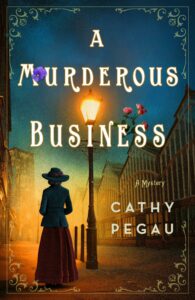Series debut
 This is an “old school” read, with everything good that comes to mind when you hear that phrase, which is to say it’s well structured, well written, with vivid characters and a plot that moves efficiently to the conclusion. While this is a series debut, it’s far from Ms. Pegau’s maiden novel, as she’s written an assortment of others in various genres, including other mysteries. This one is set in 1912 New York, anchored by references to the recent sinking of the Titanic.
This is an “old school” read, with everything good that comes to mind when you hear that phrase, which is to say it’s well structured, well written, with vivid characters and a plot that moves efficiently to the conclusion. While this is a series debut, it’s far from Ms. Pegau’s maiden novel, as she’s written an assortment of others in various genres, including other mysteries. This one is set in 1912 New York, anchored by references to the recent sinking of the Titanic.
As the book opens, main character Margot Harriman, who has taken over the family canning and food company, B&H Foods, after her father’s death, and is regarded with some skepticism by her assortment of male board members and company officers, discovers the body of a loyal former employee in a company office. Adding to the mystery is that the woman was nominally retired and has left a note for Margot, suggesting that there has been some long-standing chicanery at the plant.
Margot doesn’t want to go to traditional law enforcement and drag her family’s name through the mud, so she finds a discreet private investigation firm, now headed by a young woman whose father is sliding into dementia. While she doesn’t make this situation understood to Margot at their first meeting, in subsequent ones it becomes clear that the two women share this particular bond, as well as another, as both are gay women operating in a twilight world early in the 20th century.
I will say this is the second excellent novel I’ve read this year with a gay woman working in a traditionally male field at the center, and in Margot’s case it’s two of them, big business and private detection. (The first was Rob Osler’s The Case of the Missing Maid). Hopefully this is a sign of more characters like Osler’s Harriet and Pegau’s Margot. It’s about time.
As the story progresses Margot and the investigator, Loretta (Rett for short) unravel layer after layer of corruption at B & H Foods, eventually having to deal with another murder as well. Mostly Rett investigates and reports back, but Margot can’t keep her nose out of things and pops up at the denouement. Both have good left hooks, which comes in handy once or twice.
The story is brisk and appropriately complicated, and the main characters of both Margot and Rett are so appealing that I’m hoping this is the start of a long lived series. The manufacturing universe was an unusual setting for a mystery, which added excellent specificity to the story. (For example, how were vegetables prepared for canning in 1912? You’ll find out). I liked that Margot could drive (a fairly unusual skill for the time) but wasn’t comfortable enough with her driving to want to dispense with a chauffeur. If you enjoy a good story well told, you’re in business. — Robin Agnew